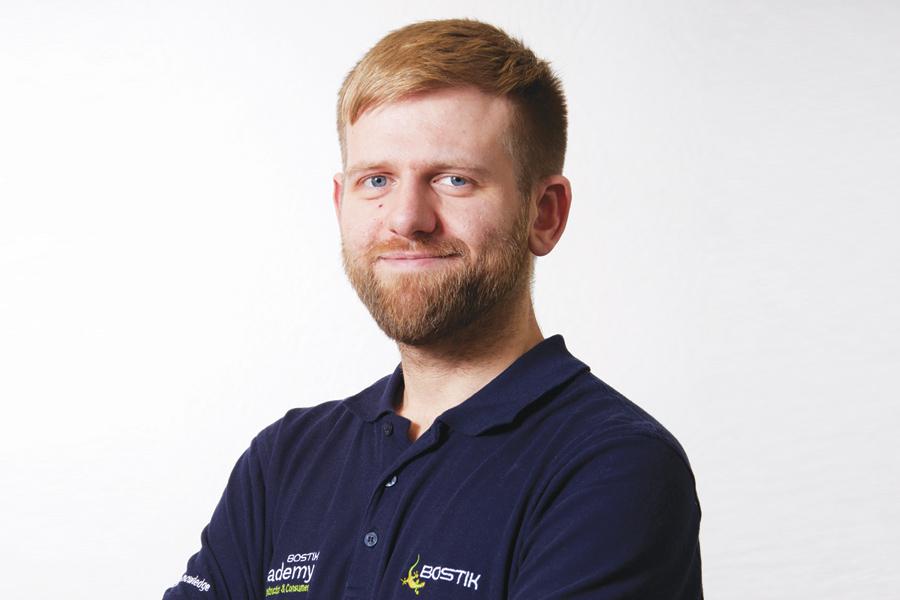Adam Jones elaborates on what to look at when you’re choosing a single or two-component moisture control system.
EXCESS moisture is a common yet potentially troublesome factor to consider when installing flooring. Historically, moisture-related issues accounted for the vast majority of all flooring failures – and so the need to use a surface-applied moisture control system is generally well understood in the industry. Traditionally, this has always been a two-component, epoxy damp-proof membrane (DPM). Resin DPMs are very robust products that require two components to be mixed together before they are applied to the substrate.
Although these products offer extremely high-performance characteristics, there can be drawbacks. DPM components, before they’re mixed, carry with them some health and environmental concerns associated with epoxy resin.
Prolonged curing times, especially when it’s cold, can add extra time to projects. And, being a chemically reactive product, DPM resins can be wasteful due to whole units needing to be mixed, which may be more than the area requires.
In recent years, manufacturers such as Bostik have released alternative, single component products (moisture suppressants) that are more user-friendly for the applicator. They’re ready mixed, re-sealable and have far less environmental and health concerns associated with them.
These newer, single component products offer a much faster drying time and generally don’t require priming, which, when coupled together, can save the contractor significant time preparing a project to receive smoothing compounds. The contractors can protect the floor from moisture and get the smoothing compound applied on the same day – a process which could be two-to-three times longer with epoxy products.
These single component suppressants also come with some limitations though. They can only be used when the correct conditions are met, so there are some key factors you should consider when choosing one type of system over the other.
The first consideration is the actual moisture content of the substrate on which a moisture control system needs to be applied. Single component moisture suppressants are typically not rated up to the same relative humidity (RH) percentages as the two-component epoxy systems (typically 98%RH for epoxy and 95%RH for single part suppressants).
As a result, they cannot be used if the substrate is extremely fresh and still retains significant moisture. Equally, if the building is direct-to-earth with no base DPM to prevent moisture ingress, then a single component product is just not robust enough to control the moisture, as the subfloor could become fully saturated. In these situations, a two-component product must be used.
If underfloor heating (UFH) is also present in the substrate, this can reduce the maximum acceptable moisture level further, owing to the heating increasing the rate at which the moisture is trying to escape the subfloor.
The substrate type is also a very important factor to consider when selecting which moisture control system to use. Single component moisture control systems rely heavily on the absorbency into the base substrate to form a sufficient bond, so this renders them only suitable for use with substrates that can facilitate this, such as sand/cement screed and well prepared, open textured concrete.
Certain substrates, such as power-floated concrete and cement-based flowing screeds can have an extremely dense surface finish. Extremely rigorous mechanical preparation would have to be undertaken if considering the use of a single component product.
When considering the use of a moisture control system upon calcium sulphate-based screeds, a two-component product should always be used. As well as providing moisture control, these products will also prevent the passage of sulphates that can react adversely with cement based smoothing compounds.
The quality of the substrate will also impact your choice of moisture control system. Sometimes a substrate that would usually be suitable for a single component system may have cracking or fracturing present, which may require specific treatment with a repair system.
These repair systems are typically epoxy or PU-based products, so once these are applied and cured, they inhibit any potential absorbency into the substrate around the crack. Therefore, the absorbent base is no longer available, which doesn’t provide a sufficient base for a single component system.
The final point I will touch on, is to consider how deep the smoothing compound application will be. If a depth of 10mm is exceeded, the tension on the subfloor below becomes far greater, so higher-spec smoothing compounds and primers with higher compressive strength need to be used. Two-component systems should always be used for deep applications to ensure a sufficiently strong bond to the subfloor.
So, in summary, the single component products are, as a general rule, far more user friendly but less versatile than two-component systems. Ultimately, it’s always best to check with the technical department of your preferred manufacturer to make sure the chosen product will meet the demands of your installation, not only at the time of fitting, but for years to come!
adam.jones@bostik.com
www.bostik-profloor.co.uk
Adam Jones is technical consultant, Bostik UK


